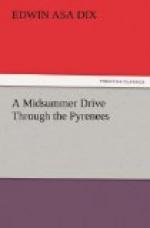This is Eaux Bonnes, as it is, as it was, as it will be. The place cannot grow, except into the air. Its area is little over half an acre. It stands wedged into the Gourzy, on a species of platform in a huge niche in the mountain, partitioned off from the main valley by the low ridge of rock behind the houses on the farther side of the park. Save this attractive little grove in its centre, every inch of ground is utilized. The torrent, tearing past along the lower bottom of the main ravine without, has cut away the level on that side; beyond it, the mountains rise sheerly upward again. And the Gourzy, as just said, hems us in on the sides remaining. From the rear windows of the Hotel des Princes you can put out your hand and touch the naked rock. A few additional houses are perched here and there on convenient projections or lodged in narrow crannies against the hill; and blasting and cutting have created space where it was not before; but the limit seems reached, and what is must be Eaux Bonnes cannot afford to increase in popularity. Popularity has seriously incommoded her already. Like a full-bodied but tight-bodiced dowager, she devoutly hopes she will not have to grow any fatter.
As I saunter back through the park, I meet a striking individual. It is one of the local guides arrayed in full regimentals. His startling colors are designed to attract the wary but inquisitive tourist,—much as the waving of the hunter’s colored scarf is said to attract the wary but inquisitive gnu. Still it is the true Ossalois dress, and as such claims inspection. I open a conversation, and find the man to be one of the four Eaux Bonnes guides having the honor of mention in Murray; Caillou Martin is his name. A broad, good-humored face, swarthy and strong, with the eyes dark and small and far apart, and shaded by the inevitable berret. Caillou’s is scarlet, and so is his jacket, thrown open in flapping lappels and showing a white flannel waistcoat beneath. He wears knee-breeches of brown corduroy, and thick creamy-white leggings, coarsely knit and climbing up over ankle and calf nearly to the knee. He has hemp sandals, and around the waist circles a scarlet sash, equally inevitable with the berret.
Caillou grins as I tell him of Murray’s encomiums, and wants us to go up the Pic de Ger. The day is "magnifique", the ascent "tres facile" the view "ravissante.” And each adjective is set off with a rattling fusillade of crackings from his great whip. This weapon is a specialty of all Pyrenean guides and drivers. The handle, short and stout, is of wood, with a red plush tuft around the centre, and the lash is made of braided leather thongs, four or five feet in length, finishing in a long whipcord and a vicious little knot. This instrument will make a crack like a pistol shot, and under artistic manipulation will signal as far as Roland could wind his famous horn. It is worn slung over the shoulder and under the opposite arm, the handle in front linking by a loop with the lash; and it fitly completes a highly picturesque costume. We bargain for the whip on the spot, a five-franc piece changes hands, and Caillou Martin graciously writes his honored autograph on the handle.




